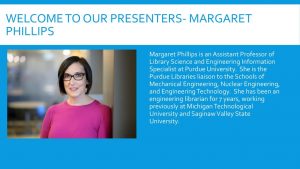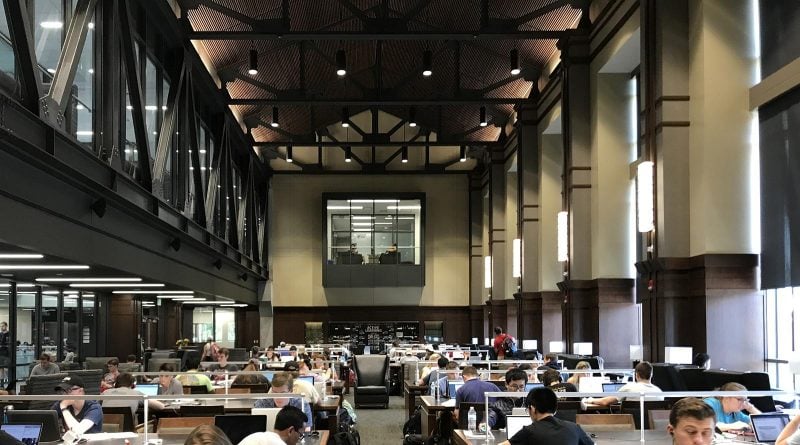Tell us something about your background, and how it’s contributed to your particular outreach methods.
I have worked diligently as an academic STEM librarian for the past eight years to become increasingly effective at library outreach. At three different institutions (Michigan Technological University, Saginaw Valley State University, and currently Purdue University), I served as the library liaison to various STEM schools and departments, including chemistry, electrical and computer engineering (ECE), engineering technology (ET), industrial engineering (IE), mechanical engineering (ME), and nuclear engineering (NE).
Can you elaborate on what you are doing at your current job?
At Purdue, I currently serve as the liaison to the following schools: ET, IE, ME, and NE. In total, this represents over 220 faculty members. With this faculty-librarian ratio, I know it isn't possible to cultivate deep relationships with all the faculty members in my liaison areas. I need to use strategies that are scalable enough to reach all faculty members in my areas with specific communications. These are designed to foster rich relationships with key individuals, ones who are library supporters and influencers in their schools.
Tell us about your philosophy of outreach.
Library outreach is not for the faint of heart. Successful outreach requires actively keeping up-to-date with user needs and library resources. It also demands a myriad of skills and personal traits, such as strong communication skills, creativity, courage, passion, resilience, a commitment to continuous improvement, and persistence.
Can you elaborate on the specifics of what you do?
For scalable strategies, I use classic approaches, such as presenting at faculty meetings and sending brief, relevant messages to faculty email lists. This always is done with a keen focus on tailoring the communications to the specific audience and using best design practices. I highlight what is new in the Purdue Libraries and most relevant to their disciplines. To cultivate deep relationships, I use a variety of approaches. Initially, I scan school/department websites and attend school/department-sponsored workshops and talks to make in-person connections. I then ask questions about what kinds of things are challenges for them as faculty members, or what they see as challenges for students in their courses, or those they advise. I try to encourage faculty members to think broadly as they answer this question, as some individuals, initially, have a fairly narrow understanding of the purview of modern academic libraries.

You provide librarian-specific assistance, yes?
Depending on the faculty responses, I offer support: This ranges from connecting them to specific resources, to ordering materials, to arranging vendor demonstrations, to offering to teach class sessions on information and data-related topics for their students. Lately, I have had a great deal of interest from engineering and technology design instructors on using materials I created (or co-created) in their courses, such as online tutorials focused on technical standards (e.g., the International Organization of Standardization (ISO) standards) and patents.
You work closely with those researchers writing papers.
This strategy has also resulted in forming research collaborations with STEM faculty members to co-author papers. We work on grant-funded projects, which, in turn, has led to even more relationships, as I move from being their liaison librarian to a potential research partner.
What about student outreach?
Just as I do with faculty members, I conduct outreach to students, using scalable approaches designed to reach a mass of students. I offer key information about the libraries. I also provide more tailored approaches targeting individual course and student needs.
This starts right after the students arrive, correct?
The first significant exposure librarians have to students at Purdue is during new student orientation. I, along with many faculty and staff members in the Purdue Libraries, lead undergraduate orientation sessions for approximately 350-400 students during this action-packed week. We know the students are presented with copious amounts of new information, so we strive to make our sessions lively and memorable. During the last two years, we have recruited student orientation leaders to play an improv game called “Battledecks” (aka PowerPoint Karaoke), where they deliver short presentations about the libraries using PowerPoint slides embedded with new (to them) memes and animation. This approach has resulted in the libraries receiving the highest student reviews of the orientation sessions held on campus.
There is a role for data and feedback, yes?
I conduct more targeted library outreach to undergraduate and graduate students. I do this in the information and data literacy classes I teach as an instructor or co-instructor of record. I also do it during the library one-shot and embedded sessions I’ve been invited to deliver by course instructors. For nearly all courses, I utilize survey and audience polling applications, such as Qualtrics and Mentimeter. This way, I learn more about the students’ specific needs and how to foster active learning. For some courses, I work with faculty members to develop required information-focused assignments, such as an annotated bibliography assignment for an engineering technology capstone experience (that is used with an in-house peer calibration application).
And there is a role for just staying at it, too?
I have found successful approaches through persistence, trial and error, and not being afraid to try new approaches — even those that may fail initially. And I must give credit to my colleagues at Purdue, Saginaw Valley State, and Michigan Tech for collaborating with me to develop, deliver, and refine many of these approaches over the past eight years.

